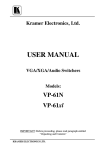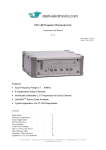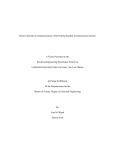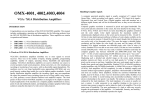Download USER MANUAL - Kramer Electronics
Transcript
KRAMER ELECTRONICS, Ltd. USER MANUAL VGA/XGA Twisted Pair Transmitter and Receiver Models: TP-15 TP-16 IMPORTANT: Before proceeding, please read paragraph entitled "Unpacking and Contents:" Table Of Contents Section Name Page 1 1.1 1.2 1.3 2 3 4 4.1 5 5.1 6 6.1 7 7.1 7.2 8 8.1 8.2 8.3 9 10 11 11.1 11.2 INTRODUCTION A Word on Twisted Pair Interfaces Handling Graphic Signals Factor Affecting Quality of Results SPECIFICATIONS HOW DO I GET STARTED? UNPACKING and CONTENTS Optional Accessories TWISTED PAIR LINE TRANSMITTERS AND RECEIVERS Getting to Know Your TP-15 VGA/XGA Line Transmitter INSTALLATION How to Setup a Twisted-Pair System? CONNECTING TO VGA/XGA SOURCE AND ACCEPTOR Connecting to the Line Transmitter / Receiver Effective Operating Range USING THE VGA/XGA TWISTED PAIR SET Powering On the Twisted Pair Set Equalization Control Additional Uses TYPICAL VGA/XGA TWISTED PAIR LINK TAKING CARE OF YOUR TWISTED PAIR MACHINES TROUBLESHOOTING Power and Indicators VGA/XGA Signal Limited Warranty 1 1 1 2 3 4 4 4 6 7 8 8 8 8 8 9 9 9 9 9 11 11 11 11 12 List Of Illustrations Figure 1 2 3 Table 1 2 Page TP-15 Front/Rear Panel Features TP-16 FRONT/REAR PANEL FEATURES TYPICAL VGA/XGA TWISTED PAIR SETUP 6 7 10 List Of Tables TP-15 FRONT/REAR PANEL FEATURES TP-16 FRONT/REAR PANEL FEATURES 6 7 ADDENDUM: Included with user manuals for machines with a CAT5 connector This addendum describes the Power Connect feature used with Kramer machines, and the choice between STP and UTP CAT5 cables. Power Connect Feature1 The Power Connect feature lets you power a transmitter / receiver system by connecting just one power adapter to either the transmitter or the receiver. The other unit is fed over the same CAT5 cable. The Power Connect feature applies as long as the CAT5 cable is heavy gauge cable (that is, it can carry power). The distance does not exceed 50 meters on standard cable. For a distance of 100 meters, separate power supplies must be connected to the transmitter and to the receiver simultaneously, unless using heavy gauge CAT5 cable. Shielded Twisted Pair (STP) / Unshielded Twisted Pair (UTP) The decision whether to use shielded twisted pair (STP) cable or unshielded twisted pair (UTP) cable depends on the nature of the application. It is recommended that in applications with high interference, shielded twisted pair (STP) cable will give better results. However, the shield itself does create a capacitance that degrades the frequency response of the machines. For shorter distances, of 50m or so, shielded twisted pair (STP) cable is preferred because it provides protection from interference (degradation is non-apparent). For a long range application, unshielded twisted pair (UTP) cable is preferred. However, the unshielded twisted pair (UTP) cable should be installed far away from electric cables, motors etc., which are prone to create electrical interference. 1 This section of the addendum is only relevant to machines that support this feature (for example, the TP-104; not the TP-100) P/N: 2900 – 9999991 A1 INTRODUCTION Congratulations on your purchase of this Kramer Electronics Twisted Pair equipment. Since 1981 Kramer has been dedicated to the development and manufacture of high quality video/audio equipment. The Kramer line has become an integral part of many of the best production and presentation facilities around the world. In recent years Kramer has redesigned and upgraded most of the line, making the best even better. Kramer’s line of professional video/audio electronics is one of the most versatile and complete available, and is a true leader in terms of quality, workmanship, price/performance ratio and innovation. In addition to the Kramer line of high quality Twisted Pair Interfaces, such as you have just purchased, Kramer also offers a full line of high quality distribution amplifiers, switchers, processors, interfaces, controllers and computer-related products. This manual includes configuration, operation and option information for the following products from the Kramer line of Twisted Pair Interfaces: TP-15 - Video Line Transmitter TP-16 - Video Line Receiver A Word on Twisted Pair Interfaces Twisted Pair technology significantly simplifies studio and industrial wiring. The price of Twisted Pair wire is far lower than that of coaxial cables, so it is attractive for many applications. The Twisted Pair interfaces are divided into three families as follows: Twisted Pair Transmitters - used to convert video, audio and PC generated VGA/XGA signals to a twisted-pair signal format (balanced line). The twisted pair transmitters have useraccessible trimmers or controls for signal level and cable compensation. Twisted Pair Receivers - used to convert a twisted pair format signal to video, audio or PC generated VGA/XGA signals. The receivers have looping possibility; so several receivers may be chained together on one twisted pair wire. Twisted Pair Amplifiers - used to extend the operating distance of the twisted pair system, by adding amplification and cable compensation along the twisted pair wire. Handling Graphics signals A computer generated graphics signal is usually composed of 5 signals: Red, Green, Blue - which are analog level signals - and two TTL (logic) level signals - Horizontal Sync and Vertical Sync. (Digital graphics cards and monitors use a different signal format, and will not be discussed here.) They are called VGA, S-VGA, XGA, S-XGA and U-XGA, which are terms describing graphics resolution and color depth. Computer graphics resolution is measured in pixels and signal bandwidth. The more pixels (picture elements) on the screen, the more detailed the image. Color depth represents the maximum number of simultaneously displayed colors on the screen and is measured in bits. 24 and 32-36 bits of color depth represent millions to billions of color shades available on the screen at any given moment. It should be born in mind, though, that the human eye can resolve only a few thousands colors! The more detailed the image (higher resolution) and the higher the color depth, the more real the image will look. The highest resolution of standard VGA was 640x480 pixels with 4 bits of color (16 colors). Standard VGA was able to use more colors (256) but at a lower resolution around 320x200 pixels - which was very crude. Common resolutions used today for computer graphics vary between 1024x768 and 2000x1600 pixels with “high color” - 16 bits of color (representing 64,000 different colors) up to “true color” - 24 bits or more (representing from 16.7 million colors up to several billion.) Displaying such a detailed and colorful image on the screen needs enormous graphics memory per frame, as well as very high speeds for “writing” so many pixels on the screen in real time. Amplifiers that carry such signals must be able to handle those speeds and signal bandwidths. Standard VGA, at 640x480 resolution, needed amplifiers with 20-30MHz bandwidth. At 1600x1200 or even at 1280x1024 (S-XGA), such amplifiers will fail completely. In order to faithfully amplify and transmit modern high-resolution graphics, amplifiers with bandwidths of 300 MHz and more are needed. Those amplifiers, besides the enormous bandwidth they handle, need to be linear, to have KRAMER ELECTRONICS LTD. 1 very low distortion and to be stable. Stability of an amplifier is its ability to avoid bursting into uncontrolled oscillation, which is in adverse relationship to the speed it can handle. The tendency to oscillate is further enhanced by the load impedance. The load impedance of a system is usually not just a resistor. A cable connected to an amplifier (leading to the receiver or monitor) may present a capacitive and/or inductive load to the amplifier. This is the main cause of instability. The poor performance of a load or cable may severely degrade the performance of the amplifier - its bandwidth, linearity, and stability - and in general its ability to faithfully reproduce the signal. Cables affect image resolution. Longer cables can cause high frequency deterioration and hence image “smear” and loss of resolution. In computer graphics especially, this adverse effect is very much accentuated. Amplifiers should therefore also compensate for cable losses up to the maximum useful operation distance. High-resolution graphics systems must use very high quality cables for image transmission. The cables should be shielded - to eliminate externally induced interference though the shield may increase the capacitance of the cable and, therefore, cause deterioration of image resolution and clarity. Standard cables can only be a few meters long. For longer distances, compound cable is separated into five individual coax cables, which are bulky and cumbersome for use. Even so, the distance is limited to several tens of meters. Cables may create other problems if they fail to accurately match the system’s required impedance. The result of this, especially at high frequencies, is “shadows” or “ghosts” on the image, resulting from standing waves and electronic reflections running back and forth between transmitter and receiver. Another aspect to consider is the sync. As those signals are logic signals, which are not treated as analog signals, the receiver does not terminate the line, and therefore the line is not matched. A host of problems can occur when signals are sent over long, unterminated, unmatched cables. The result can be image breakdown or distortion due to improper sync information. The amplifier that drives the analog section of the graphics data should be able to buffer, recover and send the sync information so that it will be received properly at the receiver end. Factors Affecting Quality of Results There are many factors affecting the quality of results when signals are transmitted from a source to an acceptor: Connection cables - Low quality cables are susceptible to interference; they degrade signal quality due to poor matching and cause elevated noise levels. They should therefore be of the best quality. Sockets and connectors of the sources and acceptors - So often ignored, they should be of highest quality, since "Zero Ohm" connection resistance is the objective. Sockets and connectors also must match the required impedance (75ohm in video). Cheap, low quality connectors tend to rust, thus causing breaks in the signal path. Amplifying circuitry - Must have quality performance when the desired result is high linearity, low distortion and low noise operation. Distance between sources and acceptors - Plays a major role in the final result. For long distances (over 15 meters) between sources and acceptors, special measures should be taken in order to avoid cable losses. These include using higher quality cables or adding line amplifiers. Interference from neighboring electrical appliances - These can have an adverse effect on signal quality. Balanced audio lines are less prone to interference, but unbalanced audio should be installed far from any mains power cables, electric motors, transmitters, etc. even when the cables are shielded. KRAMER ELECTRONICS LTD. 2 SPECIFICATIONS TP-15 TP-16 Input 1 VGA/XGA - Analog R, G, B 0.7 Vpp/75 ohms, H, V syncs TTL level on HD 15F connector 5 twisted pair sets, UTP on detachable terminal block connectors. Output 5 twisted pair sets, UTP on detachable 1 VGA/XGA - Analog R, G, B terminal block connectors. 0.7 Vpp/75 ohms, H, V syncs TTL level on HD 15F connector Video S/N ratio (SET) 71 dB Bandwidth (SET) 245 MHz, -3dB (Red signal for example) @ 5m Differential Gain (SET) <0.09% Differential Phase (SET) <0.13 Deg. Non Linearity (SET) <0.3% K-Factor <0.05% Controls HF above 4.5MHz 0/+ 4.8dB, by front NA control, triple EQ. network. Dimensions (W, D, H) 22cm x 18cm x 4.5cm (8.6" x 7" x 1.8") 16.5cm x 12cm x 4.5cm (6.5" x 4.7" x 1.8") Weight 1.3 Kg. (2.9 lbs.) Approx. 0.7 Kg. (1.6 lbs.) Approx. Power consumption 5.2 VA 4.6 VA Power Source 230VAC, 50/60 Hz, (115VAC, U.S.A.) 230VAC, 50/60 Hz, (115VAC, U.S.A.) KRAMER ELECTRONICS LTD. 3 HOW DO I GET STARTED? The fastest way to get started is to take your time and do everything right the first time. Taking 15 minutes to read the manual may save you a few hours later. You don’t even have to read the whole manual. If the section doesn’t apply to you, you don’t have to spend your time reading it. UNPACKING and CONTENTS The items contained in your Kramer Twisted Pair Transmitter/Receiver package are listed below. Please save the original box and packaging materials for possible future shipment. Twisted Pair Transmitter or Receiver AC power cable User Manual Kramer Concise Catalog 4 rubber feet Optional Accessories The following accessories, which are available from Kramer, can enhance implementation of your Line Amplifier/Kramer Tool. For information regarding cables and additional accessories, contact your Kramer dealer. Rack Adapter - Used to adapt smaller machines to a standard 1U rack. One or more machines may be installed on each adapter. BNC "Y" Connector - Used for looping purposes to split the incoming signal to enable connection of an additional machine. TP-17 – (VGA/XGA Twisted Pair Line Amplifier) for range extension of the TP-15/TP-16 system. This machine doubles the range of the TP-15/16 system, and provides an additional “local” output. VP-22 - (VGA / XGA Line Amplifier & Processor) can be serially inserted either between the VGA/XGA source and the input of the TP-15, or between the output of the TP-16 and the input of the VGA/XGA acceptor, for signal processing. It is a full bandwidth, looping Line Amplifier & Processor, designed for computer and workstation applications where remote monitoring is needed. The VP-22 splits VGA/Super VGA/XGA graphics card output to 2 remote monitors and allows the user to control signal level and cable equalization for each channel independently. The machine also allows control of horizontal and vertical sync delay on the BNC coaxial outputs. On its H/HV SYNC output BNC, the VP-22 allows either horizontal or composite sync while on its green output BNC, it allows either green or green + composite sync. State-of-the-art video amplifying circuitry makes the VP-22 the perfect graphics component amplifier. Signal bandwidth of over 350MHz allows it to be used with the highest quality graphics workstations. VP-61RS - (6x1 VGA Switcher) can be serially inserted between the TP-15 input and several VGA/XGA sources for source selection. It is a full bandwidth switcher, designed for computer and workstation applications. The VP-61RS switches one of six VGA/Super-VGA/XGA graphics card outputs to one monitor or vice versa, with no discernible signal degradation. The VP-61RS also has RS-232 control. Input and output are direct coupled and conform to the highest standards. The machine has a video bandwidth exceeding 180 MHz, suitable for graphics applications. VP-101 - (VGA to RGBS Converter) can be serially inserted between the VGA/XGA output of the TP-16 and an appropriate acceptor for VGA/XGA to RGB conversion. It is a full bandwidth converter designed for computer, workstation and presentation applications. The VP-101 converts a VGA/Super-VGA/XGA graphics card output to red, green, blue, horizontal/composite sync and vertical sync. The signals are available on BNC connectors. Via a rear panel switch, the VP-101 allows the user to select either a composite or horizontal sync output. The composite sync generated maintains the correct (negative) polarity at any polarity of Hs and Vs inputs. The input and outputs are AC coupled conforming to the highest standards. The original source bandwidth is retained to well over 300MHz thus allowing the VP-101 to be used with the highest quality KRAMER ELECTRONICS LTD. 4 graphics workstations. The VP-101 is fed from a 12VDC source and is therefore suitable for fieldwork as well. VP-102 - (VGA to RGBS Converter) can be serially inserted between the VGA/XGA output of the TP-16 and an appropriate acceptor for VGA/XGA to RGB conversion. It is full bandwidth, especially designed for computer, workstation and presentation applications. The VP-102 converts a VGA/Super - VGA/XGA graphics card output to red, green, blue, horizontal/composite sync and vertical sync signals available on BNC connectors. The VP-102 allows the user to select either a composite or horizontal sync output and the green output either includes composite sync or is blanked. The composite sync generated by the machine is always at the right (negative) polarity for any polarity of Hs and Vs inputs. Signal bandwidth of well over 315MHz allows the VP-102 to be used with the highest quality graphics workstations. VP-222 - (2x1 VGA switcher distributor) can be serially inserted between the TP-16 VGA/XGA output and a VGA/XGA acceptor for VGA/XGA switching and distribution. The VP-222 allows selection of one of two VGA/XGA sources and distribution of the selected source to two independent outputs. Signal bandwidth of 365MHz ensures that the VP-222 remains transparent even in the most critical applications. The VP-222 is part of the Kramer TOOLS family of compact, high quality and cost effective solutions for a variety of applications. It is full bandwidth, designed for computer and presentation applications. VP-211 - (2x1 Automatic VGA/Audio Switcher) can be serially inserted between the TP-16 VGA/XGA output and a VGA/XGA acceptor. The VP-211 automatically detects the presence of a VGA/XGA signal on input no. 1 and routes it to the output. If the signal disappears, the machine will switch input no. 2 to the output. When the signal on input no. 1 re-appears, the VP-211 reroutes it to the output. The machine operates in audio-follow-video (VGA) mode and switches the stereo audio input appropriate to the VGA input. Signal bandwidth of 517MHz ensures that the VP-211 remains transparent even in the most critical applications. The VP-211 is part of the Kramer TOOLS family of compact, high quality and cost effective solutions for a variety of applications. It is full bandwidth, designed for computer and presentation applications. VP-800 - (VGA/XGA Bar Generator) is one of the KRAMER TOOLS. It is a unique, high quality color bar generator for testing and alignment of VGA/XGA equipment, such as monitors, projectors, etc. The VP-800 generates a color bar, similar to a TV test pattern, in the four most common resolution modes - 640x480, 800x600, 1024x768 and 1280x1024. Operation of the machine is simple - just plug an appropriate power source into the DC socket, plug a VGA/XGA cable to the "monitor OUT" socket leading to the acceptor (monitor, projector, etc.) and select the desired resolution with one of the push switches. The VP-800 eliminates the need for a full computer wherever a VGA/XGA signal has to be tested. It is DC fed, making it suitable for field operation as well. KRAMER ELECTRONICS LTD. 5 TWISTED PAIR LINE TRANSMITTERS AND RECEIVERS This section describes all the controls and connections of the VGA/XGA Twisted Pair Transmitter/Receiver. Understanding the controls and connections helps you realize the full power of your machine. Getting to Know Your TP-15 VGA/XGA Line Transmitter The Kramer TP-15/TP-16 is set of VGA/XGA-to-twisted pair transmitter and receiver. The TP-15, the transmitter, allows for cable equalization and signal amplification of the VGA/XGA signal, up to distances exceeding 300 ft. (100 meters) using simple CAT5, unshielded wires (UTP). The machine uses 5 pairs of wires, amplifying the analog RGB signals as well as stabilizing and correcting the Horizontal and Vertical sync signals. The machines have detachable terminal block connectors for easy connection and system wiring. Front panel features of the TP-15 are described in Figure and Table 1. Figure : TP-15 Front/Rear Panel Features Table 1: TP-15 Front/Rear Panel Features No. 1. 2. 3. 4. Feature Illuminated POWER switch Cable EQ. Control VGA/XGA IN connector LINE out socket 5. Power Connector KRAMER ELECTRONICS LTD. Function Supplies power to the unit. Controls cable equalization and allows for loss compensation. The input of the machine from a VGA/XGA source (PC etc.) Amplified and buffered balanced VGA/XGA output on detachable terminal block connectors (5 pairs). A 3-prong AC connector allows power to be supplied to the unit, Directly underneath this connector a fuse holder houses the appropriate fuse. 6 Getting to Know Your TP-16 VGA/XGA Line Receiver The Kramer TP-15/TP-16 is a set of VGA/XGA-to-twisted pair transmitter and receiver. The TP-16, the receiver, decodes the twisted pair signals, sent from the TP-15 transmitter, back to VGA/XGA standard signals, appropriate for standard VGA/XGA acceptors. The machines have detachable terminal block connectors for easy connection and system wiring. Front panel features of the TP-16 are described in Figure 2 and Table 2. Figure : TP-16 Front/Rear Panel Features Table 2: TP-16 Front/Rear Panel Features No. 1. 2. 3. 4. Feature Illuminated POWER switch LINE IN socket VGA/XGA OUT Power Connector KRAMER ELECTRONICS LTD. Function Supplies power to the unit. The 5 twisted pair input to the receiver on terminal blocks. The recovered VGA/XGA output signal on an HD15 connector. A 3-prong AC connector allows power to be supplied to the unit. Directly underneath this connector, a fuse holder houses the appropriate fuse. 7 INSTALLATION The VGA/XGA transmitter and receiver can be rackmounted in a standard 19” (1U) EIA rack using a special adapter (see section 4.1 "optional accessories"). Up to 2 machines may be installed on each adapter. To mount machines in the rack, follow the instructions in the installation guide enclosed with the adapter. How to Setup a Twisted-Pair System Twisted-pair wire system is very useful to transmit video, audio and VGA/XGA signals over long distances. If a new system is designed, low capacitance, high quality twisted pair wires should be selected for the job. If, however, you are trying to use existing twisted-pair wires already installed first verify the following: The existing wires do not carry any voltage - direct or induced. The existing wires have no "junctions" or breaks. There is no short between the wires or link to "ground" along the wires. For long distance operation it is recommended to use UTP (Unshielded Twisted Pair) type cables due to their low capacitance, and low signal loss. For short distances – up to 10-20 meters - STP (Shielded Twisted Pair) cables can be used for better protection. Cables should be installed as close as possible to the ground or walls and far from antennas and electricity cables to avoid lightning and EMP (Electro Magnetic Pulse), etc. The cables between all the components leading to and from the acceptors and sources should be of precisely the same length. If cable lengths are not equal, unwanted artifacts such as color smear and delay problems (mis-registration of the black and white content with the color) may appear. CONNECTING to VGA/XGA SOURCE AND ACCEPTOR Connecting to the Line Transmitter / Receiver VGA/XGA sources and output devices (such as monitors, projectors, etc.) are connected to the TP-15 and TP-16 through the HD15 connector located on the back panel. The twisted pair wire connecting the transmitter to the receiver is a 5-pair wire set of the CAT5 type, preferably unshielded (UTP). The LINE OUT socket on the TP-15 and the LINE IN socket of the TP-16 are marked with pin numbers. Each connection (pin) number must be connected to the appropriate number on the pair unit, (pin 1 of the TP-15 to pin 1 of the TP-16, etc.) Failing to do so may result in system malfunction. Color-coded wires are recommended for easy identification. Individual twisted pair sets (5 separate pairs) or combinations of wires such as a cable with two pairs plus a cable of three pair may be used, as long as all wires have identical length. Shielded cables, although “ protecting” the signals from external interference, may reduce the effective range of operation of the system due to the inherent capacitance in those cables and hence high frequency signal attenuation. As the signals involved in this system are very high frequency (approaching 200 MHz and more), extra care should be taken when a decision is made as of which cable to use. ! ! The effective operating range for XGA (1024x768) PC graphics signals, using good, low capacitance wires, is about 300 ft (100 meters). At VGA (640x480) and s-VGA (800x600) resolutions, the range may be doubled. S-XGA (1280x1024) and UXGA (1600x1200) may have a shorter operating range. It is very difficult to know best range at every resolution, as it is highly dependent on cable quality and the settings used. The operation range may be easily doubled using a line amplifier such as the Kramer TP-17, inserted in series with the twisted pair long line (at the remote location.) The TP-17 provides further line driving capacity as well as an extra local output. This “ local” output can be driven with another TP-15 to a different location, creating a “ branch” in the system. Line amplifiers may be cascaded to gain extra range, however, it is not practical to use more than two line amplifiers in series. KRAMER ELECTRONICS LTD. 8 " USING the VGA/XGA TWISTED PAIR SET " Turning on the Twisted Pair Set NOTES 1. The Twisted pair set should only be turned on after all connections are completed and all source devices have been turned on. Do not attempt to connect or disconnect any signal to the Twisted Pair set while it is on! 2. The socket-outlet should be near the equipment and should be easily accessible. To fully disconnect equipment, remove the power cord from its socket. 1. 2. " Press the toggle switch of both the TP-15 and the TP-16 on the far-left front panel to the up position. In the up position, the toggle switch glows. Operate the acceptors. Equalization Control After the system is operational and all cables are connected, check the signal at the remote location. It is preferable that a second operator, at the remote location (near the TP-16), instructs the operator (using an intercom or a telephone) at the transmitting end, near the TP-15, how much to adjust the cable EQ. Control. Visual testing is quite accurate, although it may be done more accurately using an RF generator at the transmitting side (TP-15) connected to the RED, GREEN and BLUE inputs of the HD15 connector, and having a spectrum analyzer connected to the RED, GREEN and BLUE outputs of the HD15 connector of the TP-16. The user should adjust the control slowly till a flat frequency response is achieved. When a line amplifier is inserted in series with the twisted pair wire, it is necessary to adjust twice – once near the line amplifier output, and the second time at the remote location. For each and every different cable length or brand, the system should be re-tuned. " Additional Uses The TP-15 and TP-16 set maybe used with signals other than VGA/XGA. Three analog signals (RED, GREEN, BLUE) run at the machines, which may be used for YC, composite, and component video signals (Y, R-Y, B-Y). In order to use the system for signals other than VGA/XGA, an appropriate cable/adapter is needed between the HD-15 connectors and the plugs/sockets of the system. A typical HD-15 to 5 BNC cable may be used to interface between the TP-15 and TP-16 and the BNCs of the system. The useful range for Composite, Y/C and Component video signals when using the TP-15/TP-16 set is far bigger (more than triple) than the range for VGA/XGA signals due to the lower frequency signals involved. It should be born in mind that though the EQ. Control of the TP-15 equalizes the three usable channels simultaneously, which is perfect for Component video use, it is not ideal if two different signals (Composite and Y/C) are used together. # $% & ' () ' * % +% When it is necessary to transmit VGA/XGA signals over long distances and to distribute the signals to remotely located users, as in presentation, schools, hospitals, airports, security applications and so on, good quality VGA/XGA signals can be obtained using twisted- pair wires. Figure illustrates a typical setup of Twisted Pair devices described in this manual: an incoming VGA/XGA signal from a PC source is sent a over a long distance by the TP-15, using a 5-pair twisted KRAMER ELECTRONICS LTD. 9 pair wire. The TP-16 VGA/XGA Line Receiver at the far edge of the wire receives the signal and sends it to an acceptor. This figure also includes the optional line amplifier TP-17 used where an extension of range is required. The setup requires the following steps: 1. 2. 3. 4. 5. Connect the output from the PC graphics card source to the Twisted Pair transmitter (TP-15). Connect the output of the Twisted Pair transmitter to a 5-pair twisted cable. Connect the TP-16 receiver at the remote end. Connect a VGA/XGA acceptor to the twisted pair line receiver (TP-16) output. Adjust received signal quality using the Cable EQ. control of the TP-15. If needed, insert a line amplifier (TP-17) at the end of the twisted pair line for range extension. Figure : Typical VGA/XGA Twisted Pair Setup KRAMER ELECTRONICS LTD. 10 TAKING CARE OF TWISTED PAIR MACHINES , Do not locate your Twisted Pair device in an environment where it is susceptible to dust or moisture. Both of these may damage the electronics, and cause erratic operation or failure. Do not locate your Twisted Pair device where temperature and humidity may be excessive. Doing so may also damage the electronics, and cause erratic operation or failure. Do not clean your Twisted Pair device with abrasives or strong cleaners. Doing so may remove or damage the finish, or may allow moisture to build up. Take care not to allow dust or particles to build up inside unused or open connectors. TROUBLESHOOTING NOTES: Please note that if the output signal is disturbed or interrupted by very strong external electromagnetic interference, it should return and stabilize when such interference ends. If not, turn the power switch off and on again to reset the machine. If the following recommended actions still do not result in satisfactory operation, please consult your KRAMER Dealer. Power And Indicators Problem Remedy No Power For both models TP-15 and TP-16 perform the following: 1. Confirm that the rocker switch is in the “ ON” position, and that the LED is illuminated. 2. Confirm that power connections are secured at the machine and at the receptacle. Make sure the receptacle is active, outputting the proper mains voltage. 3. Remove power cord from AC outlet and the machine and then, using a flat head screwdriver, remove the fuse holder located directly below the power connector on your machine. Confirm that the fuse is good by looking for the wire connected between the ends of the fuse. If the wire is broken, replace the fuse with another, with the same rating. 4. Install the cover by replacing the Philips screws. VGA/XGA Signal Problem No VGA/XGA at the output device, regardless of input selected. Remedy 1. 2. 3. 4. VGA/XGA level is too high or too dim. 1. 2. 3. Confirm that your sources and output device are turned on and connected properly. Confirm that any other devices in the signal path have the proper input and/or output selected. Check if the twisted pair cables are connected properly, conforming to the same pin number on both input and output. Use the Kramer VP-800 (instead of the PC graphics card source) to check whether the line and receiver are functioning properly. Verify that the VGA/XGA line is properly connected on both sides. Check whether there is no double loading on the input or output lines. Readjust the TP-15 Cable EQ. control. Mis-adjustment of this control can result in an apparent “ wrong” brightness image. KRAMER ELECTRONICS LTD. 11 Signal quality degradation: color is weak or smeared, quality of the picture is reduced, and details of the picture are lost. Inappropriate cables usually have excessive built-in capacitance. When shielded long cables are used, the capacitance grows thus causing the cable to pick more interference from RF sources, such as transmitters, computers and other appliances creating RF fields. These factors degrade signal quality due to high frequency loss and interference pickup. Long distance between signal source and the acceptors also affects the picture quality. To solve the problem perform the following: 1. Use high quality non- shielded cables (UTP type) for the longer distances (Multi Twisted Cable Wire is recommended). 2. Use a line amplifier in series with the TP (such as the TP-17) to pre compensate for signal degradation. You may cascade several line amplifiers to extend the range. 3. Readjust the Cable EQ. control of the TP-15. Problem Remedy Noise bars "roll" up or down in the output image or: Low frequency Hum in the output signal Hum bars (ground loop) are caused by a difference in the ground potential of any two or more devices connected to your signal path. Passing that voltage difference through any available interconnection, including your video cables, compensates this difference. Check the following to remove hum bars: 1. Confirm that all interconnected equipment is connected to the same phase of power, if possible. 2. Remove equipment connected to the phase that may introduce noise, such as motors, generators, etc. 3. Disconnect all cables and reconnect them one at a time until ground loop reappears. Disconnect the affected cable and replace, or insert an isolation device (opto isolator or transformer) in the signal path. LIMITED WARRANTY Kramer Electronics (hereafter Kramer) warrants this product to be free from defects in material and workmanship under the following terms. HOW LONG IS THE WARRANTY Labor and parts are warranted for three year from the date of the first customer purchase. WHO IS PROTECTED Only the first purchase customer may enforce this warranty. WHAT IS COVERED AND WHAT IS NOT COVERED Except as below, this warranty covers all defects in material or workmanship in this product. The following are not covered by the warranty: 1. Any product which is not distributed by Kramer or which is not purchased from an authorized Kramer dealer. If you are uncertain as to whether a dealer is authorized, please contact Kramer at one of the agents listed in the web site www.kramerelectronics.com. 2. Any product, on which the serial number has been defaced, modified or removed. 3. Damage, deterioration or malfunction resulting from: a) Accident, misuse, abuse, neglect, fire, water, lightning or other acts of nature, unauthorized b) product modification, or failure to follow instructions supplied with the product. c) Repair or attempted repair by anyone not authorized by Kramer. d) Any shipment of the product (claims must be presented to the carrier). e) Removal or installation of the product. f) Any other cause, which does not relate to a product defect. g) Cartons, equipment enclosures, cables or accessories used in conjunction with the product. KRAMER ELECTRONICS LTD. 12 WHAT WE WILL PAY FOR AND WHAT WE WILL NOT PAY FOR We will pay labor and material expenses for covered items. We will not pay for the following: 1. Removal or installations charges. 2. Costs of initial technical adjustments (set-up), including adjustment of user controls or programming. These costs are the responsibility of the Kramer dealer from whom the product was purchased. 3. Shipping charges. HOW YOU CAN GET WARRANTY SERVICE 1. To obtain service on you product, you must take or ship it prepaid to any authorized Kramer service center. 2. Whenever warranty service is required, the original dated invoice (or a copy) must be presented as proof of warranty coverage, and should be included in any shipment of the product. Please also include in any mailing a contact name, company, address, and a description of the problem(s). 3. For the name of the nearest Kramer authorized service center, consult your authorized dealer. LIMITATION OF IMPLIED WARRANTIES All implied warranties, including warranties of merchantability and fitness for a particular purpose, are limited in duration to the length of this warranty. EXCLUSION OF DAMAGES Kramer’ s liability for any defective products is limited to the repair or replacement of the product at our option. Kramer shall not be liable for: 1. 2. Damage to other property caused by defects in this product, damages based upon inconvenience, loss of use of the product, loss of time, commercial loss; or Any other damages, whether incidental, consequential or otherwise. Some countries may not allow limitations on how long an implied warranty lasts and/or do not allow the exclusion or limitation of incidental or consequential damages, so the above limitations and exclusions may not apply to you. This warranty gives you specific legal rights, and you may also have other rights, which vary from place to place. NOTE: All products returned to Kramer for service must have prior approval. This may be obtained from your dealer. NOTICE This equipment has been tested to determine compliance with the requirements of: EN-50081: EN-50082: CFR-47 "Electromagnetic compatibility (EMC); generic emission standard. Part 1: Residential, commercial and light industry" "Electromagnetic compatibility (EMC) generic immunity standard. Part 1: Residential, commercial and light industry environment". FCC Rules and Regulations: Part 15- “ Radio frequency devices: Subpart B- Unintentional radiators CAUTION! Servicing the machines can only be done by an authorized Kramer technician. Any user who makes changes or modifications to the unit without the expressed approval of the manufacturer will void user authority to operate the equipment. Use the supplied DC power supply to feed power to the machine. Please use recommended interconnect cables to connect the machine to other components. KRAMER ELECTRONICS LTD. 13 For the latest information on our products and a list of Kramer distributors, visit our Web site: www.kramerelectronics.com. Updates to this user manual may be found at http://www.kramerelectronics.com/manuals.html. We welcome your questions, comments and feedback. Kramer Electronics, Ltd. Web site: www.kramerelectronics.com E-mail: [email protected] P/N: 2900-007015 REV 2


































